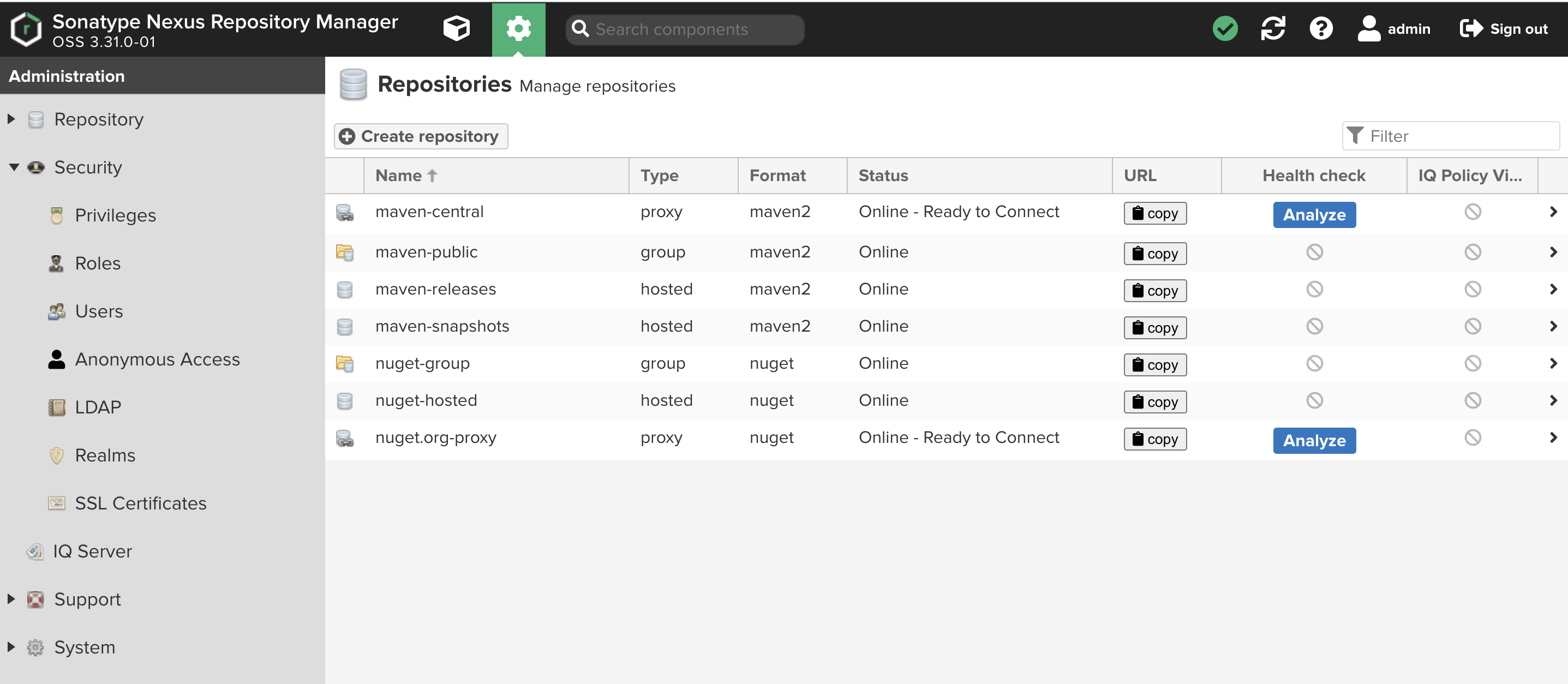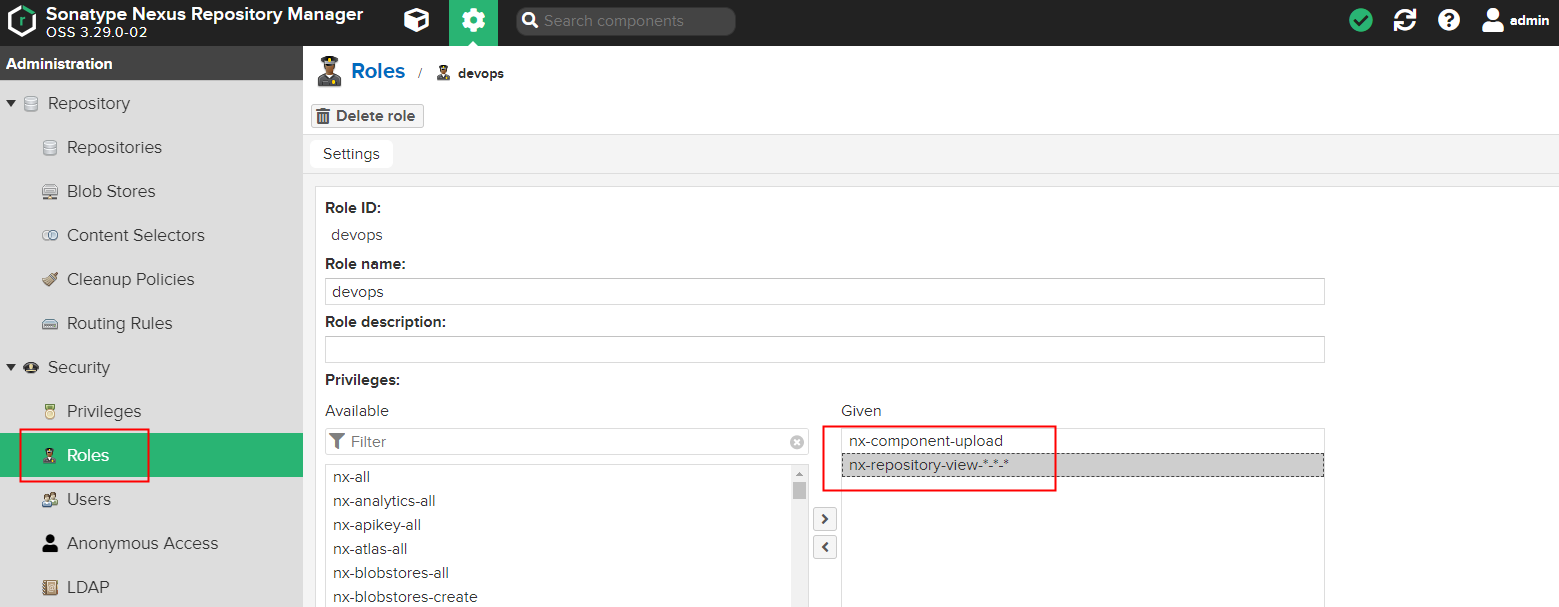Nexus 安装配置教程
为什么使用 Nexus#
Nexus 最为大家熟知的功能就是 maven 的依赖包管理器。其实 Nexus 的功能不仅仅是 maven 的包管理,它还可以做 .net 包管理,docker 镜像管理,甚至还可以做 yum 源。这篇文章主要介绍 Nexus 的 maven 依赖管理功能,介绍 Nexus 的安装,配置。
架设 Nexus 私服有以下优点:
- 节省公司外网贷款;
- 因为依赖会被缓存到私服上,所以依赖的下载速度会很快;
- 方便上传团队内部的依赖,统一管理,共享。
Docker 模式安装 Nexus#
我们选择使用 Docker 的方式安装 Nexus。
Nexus的官方网站:https://www.sonatype.com/products/repository-oss-download
Nexus的官方帮助文档:https://help.sonatype.com/repomanager3
Nexus的Docker安装介绍:https://help.sonatype.com/repomanager3/installation/installation-methods#InstallationMethods-InstallingwithDocker
官方有两种方式
- 使用 docker 的 data volume (推荐)
- 使用本地目录作为 container 的 volume
使用 data volume#
docker volume create --name nexus-data
docker run -d -p 8081:8081 --name nexus -v nexus-data:/nexus-data sonatype/nexus3
使用本地目录#
mkdir nexus
cd nexus
docker run -d -p 8081:8081 --name nexus -v $PWD/nexus-data:/nexus-data sonatype/nexus3
安装起来特别简单。
安装完毕,访问 127.0.0.1:8081,可以直接登陆。
Nexus 配置#
关于怎么配置 Nexus 这边不做太详细的说明。对默认的几个仓库坐下说明。
默认情况下,Nexus 会帮我们创建几个仓库:
- maven-central:代理仓库,一般会连接外部的中央仓库;
- maven-public:仓库组,一般提供这个仓库给公司内部的同事使用;
- maven-release:本地仓库,一般用于存放公司内部开发的Jar包;
- maven-snapshots:本地仓库,存放公司开发的snapshot版本的包;
- maven-3rd-party:本地仓库,存放第三方的Jar包。
配置 Blob Stores#
Nexus 使用#
包下载#
如果你只需要使用包下载功能,只需要替换本地的settings.xml即可。
<settings>
<localRepository>D:\software\maven\Repository</localRepository>
<proxies></proxies>
<servers>
<server>
<id>nexus</id>
<username>devops</username>
<password>password</password>
</server>
</servers>
<mirrors>
<mirror>
<id>nexus</id>
<mirrorOf>nexus</mirrorOf>
<url>http://xx.xx.xx.xx:18081/repository/maven2-public/</url>
</mirror>
</mirrors>
<profiles>
<profile>
<id>nexus</id>
<repositories>
<repository>
<id>nexus</id>
<url>http://nexus</url>
<releases>
<enabled>true</enabled>
</releases>
<snapshots>
<enabled>true</enabled>
</snapshots>
</repository>
</repositories>
<pluginRepositories>
<pluginRepository>
<id>nexus</id>
<url>http://nexus</url>
<releases>
<enabled>true</enabled>
</releases>
<snapshots>
<enabled>true</enabled>
</snapshots>
</pluginRepository>
</pluginRepositories>
</profile>
</profiles>
<activeProfiles>
<activeProfile>nexus</activeProfile>
</activeProfiles>
</settings>
包上传#
方法一:通过 Nexus 界面上传
给用户开通上传Jar包的权限。用户就可以通过页面上传Jar包了。
方法二:通过配置pom文件进行Jar包上传
在项目的pom中加入以下的配置。
<distributionManagement>
<snapshotRepository>
<!--注意,这个Id需要和上面的setting文件中的server标签中的id一一致-->
<id>nexus</id>
<name>nexus-snapshot</name>
<url>http://xx.xx.xx.xx:18081/repository/maven2-snapshots/</url>
</snapshotRepository>
<repository>
<id>nexus</id>
<name>nexus-release</name>
<url>http://xx.xx.xx.xx:18081/repository/maven2-releases/</url>
</repository>
</distributionManagement>
完成此步骤后,我们就可以通过执行mvn clean deploy进行发布了。Deploy插件会根据Maven项目中定义的version值决定是使用nexus-snapshot仓库还是nexus-release仓库。当version值是以-SNAPSHOT后缀结尾时,则发布到nexus-snapshot仓库。
方法三:通过命令行(实质和上面pom的形式一样)
mvn deploy:deploy-file -DgroupId=com.jd.jr.xx -DartifactId=gateway-xx -Dversion=1.8.xx-SNAPSHOT -Dpackaging=jar -Dfile=xx-api-1.8.0-RELEASE.jar -Durl=http://124.205.xx.xx:18081/repository/maven2-snapshots/ -DrepositoryId=nexus
上面的-DrepositoryId=nexus需要和配置的server标签匹配起来。
参考#
作者:程序员自由之路
出处:https://www.cnblogs.com/54chensongxia/p/14911406.html
版权:本作品采用「署名-非商业性使用-相同方式共享 4.0 国际」许可协议进行许可。





【推荐】国内首个AI IDE,深度理解中文开发场景,立即下载体验Trae
【推荐】编程新体验,更懂你的AI,立即体验豆包MarsCode编程助手
【推荐】抖音旗下AI助手豆包,你的智能百科全书,全免费不限次数
【推荐】轻量又高性能的 SSH 工具 IShell:AI 加持,快人一步
· go语言实现终端里的倒计时
· 如何编写易于单元测试的代码
· 10年+ .NET Coder 心语,封装的思维:从隐藏、稳定开始理解其本质意义
· .NET Core 中如何实现缓存的预热?
· 从 HTTP 原因短语缺失研究 HTTP/2 和 HTTP/3 的设计差异
· 周边上新:园子的第一款马克杯温暖上架
· Open-Sora 2.0 重磅开源!
· 分享 3 个 .NET 开源的文件压缩处理库,助力快速实现文件压缩解压功能!
· Ollama——大语言模型本地部署的极速利器
· DeepSeek如何颠覆传统软件测试?测试工程师会被淘汰吗?